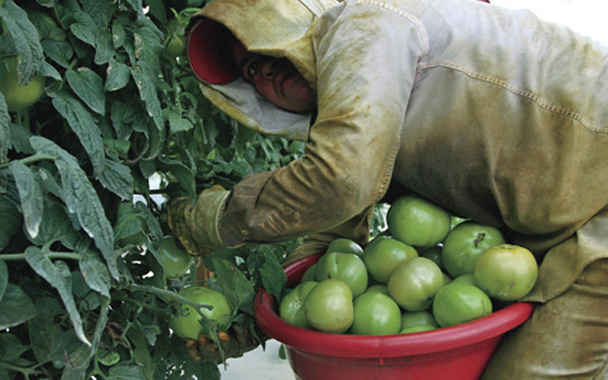Driving from Naples, Florida, the nation’s second-wealthiest metropolitan area, to Immokalee takes less than an hour on a straight road. You pass houses that sell for an average of $1.4 million, shopping malls anchored by Tiffany’s and Saks Fifth Avenue, manicured golf courses. Eventually, gated communities with names like Monaco Beach Club and Imperial Golf Estates give way to modest ranches, and the highway shrivels from six lanes to two. Through the scruffy palmettos, you glimpse flat, sandy tomato fields shimmering in the broiling sun. Rounding a long curve, you enter Immokalee. The heart of town is a nine-block grid of dusty, potholed streets lined by boarded-up bars and bodegas, peeling shacks, and sagging, mildew-streaked house trailers. Mongrel dogs snooze in the shade, scrawny chickens peck in yards. Just off the main drag, vultures squabble over roadkill. Immokalee’s population is 70 percent Latino. Per capita income is only $8,500 a year. One third of the families in this city of nearly 25,000 live below the poverty line. Over one third of the children drop out before graduating from high school.
Immokalee is the tomato capital of the United States. Between December and May, as much as 90 percent of the fresh domestic tomatoes we eat come from south Florida, and Immokalee is home to one of the area’s largest communities of farmworkers. According to Douglas Molloy, the chief assistant U.S. attorney based in Fort Myers, Immokalee has another claim to fame: It is “ground zero for modern slavery.”
The beige stucco house at 209 South Seventh Street is remarkable only because it is in better repair than most Immokalee dwellings. For two and a half years, beginning in April 2005, Mariano Lucas Domingo, along with several other men, was held as a slave at that address. At first, the deal must have seemed reasonable. Lucas, a Guatemalan in his thirties, had slipped across the border to make money to send home for the care of an ailing parent. He expected to earn about $200 a week in the fields. Cesar Navarrete, then a 23-year-old illegal immigrant from Mexico, agreed to provide room and board at his family’s home on South Seventh Street and extend credit to cover the periods when there were no tomatoes to pick.
Lucas’s “room” turned out to be the back of a box truck in the junk-strewn yard, shared with two or three other workers. It lacked running water and a toilet, so occupants urinated and defecated in a corner. For that, Navarrete docked Lucas’s pay by $20 a week. According to court papers, he also charged Lucas for two meager meals a day: eggs, beans, rice, tortillas, and, occasionally, some sort of meat. Cold showers from a garden hose in the backyard were $5 each. Everything had a price. Lucas was soon $300 in debt. After a month of ten-hour workdays, he figured he should have paid that debt off.
But when Lucas—slightly built and standing less than five and a half feet tall—inquired about the balance, Navarrete threatened to beat him should he ever try to leave. Instead of providing an accounting, Navarrete took Lucas’s paychecks, cashed them, and randomly doled out pocket money, $20 some weeks, other weeks $50. Over the years, Navarrete and members of his extended family deprived Lucas of $55,000.
Taking a day off was not an option. If Lucas became ill or was too exhausted to work, he was kicked in the head, beaten, and locked in the back of the truck. Other members of Navarrete’s dozen-man crew were slashed with knives, tied to posts, and shackled in chains. On November 18, 2007, Lucas was again locked inside the truck. As dawn broke, he noticed a faint light shining through a hole in the roof. Jumping up, he secured a hand hold and punched himself through. He was free.
What happened at Navarrete’s home would have been horrific enough if it were an isolated case. Unfortunately, involuntary servitude—slavery—is alive and well in Florida. Since 1997, law-enforcement officials have freed more than 1,000 men and women in seven different cases. And those are only the instances that resulted in convictions. Frightened, undocumented, mistrustful of the police, and speaking little or no English, most slaves refuse to testify, which means their captors cannot be tried. “Unlike victims of other crimes, slaves don’t report themselves,” said Molloy, who was one of the prosecutors on the Navarrete case. “They hide from us in plain sight.”
And for what? Supermarket produce sections overflow with bins of perfect red-orange tomatoes even during the coldest months—never mind that they are all but tasteless. Large packers, which ship nearly $500 million worth of tomatoes annually to major restaurants and grocery retailers nationwide, own or lease the land upon which the workers toil. But the harvesting is often done by independent contractors called crew bosses, who bear responsibility for hiring and overseeing pickers. Said Reggie Brown, executive vice president of the Florida Tomato Growers Exchange, "We abhor slavery and do everything we can to prevent it. We want to make sure that we always foster a work environment free from hazard, intimidation, harassment, and violence." Growers, he said, cooperated with law-enforcement officers in the Navarette case.




 Pinterest
Pinterest






